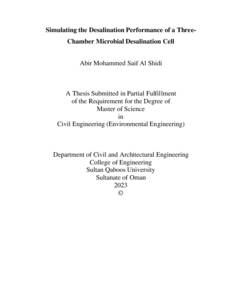Document
Simulating the desalination performance of a three chamber microbial desalination cell.
Other titles
نمذجة كفاءة تحلية المياه عن طريق تجربة الغرفة الثلاثية المكروبيولوجية
Publisher
Sultan Qaboos University.
Gregorian
2023
Language
English
English abstract
Reverse osmosis and distillation (with or without membrane) are the major
conventional desalination techniques that use huge solar or electrical energy. Such
energy-intensive desalination techniques are expensive and unsustainable. Therefore,
a sustainable and ecofriendly desalination technique is essential to minimize the
adverse impacts on the environment. Microbial Desalination Cell (MDC) is a green
and low-cost alternative desalination method that uses bacteria as a tool to generate
electricity from the biodegradation of organics present in wastewater. The biologically
produced cell potential and electricity drive the ions (mostly Na+
and Cl-
) transport
across the membranes to achieve seawater desalination. Such a microbial desalination
technique is a completely eco-friendly and green technology as it requires no external
energy input. Recently, few studies have been done on the MDC reactor design,
development of MDC electrode and membrane materials, optimizing the operational
conditions, and enhancing the desalination and waste removal performances.
However, limited studies have been done to develop the mathematical models of MDC
system for future performance and real application prediction. Therefore, this study
aims to develop a Support Vector Regression (SVR) mathematical model to predict
the MDC performance with time under various operation conditions using MATLAB
as a tool. The model has been validated by a bench-scale experimental demonstration
of MDC in the Water and Wastewater laboratory at Sultan Qaboos University, Muscat,
Sultanate of Oman. The parameters contributing to MDC system performance were
used as inputs for proper validation, including external resistance (Rext), time (t),
electrical conductivity (EC) and pH of anode, cathode and desalination chambers, and
biogenerated current flow (I). Two types of MDC, Air Pumped Microbial Desalination
Cell (APMDC) and Air Cathode Microbial Desalination Cell (ACMDC) were used for
validation purposes. The salt removal performances obtained from the experiment
were used as an output variable. The SVR models were trained and cross-validated,
and the sensitivity analysis was employed to evaluate and state model output. The
kernel function polynomial, radial basis function (rbf) and Gaussian kernels were
vi
selected and optimized for the developed SVR model based on the set of data and
model purpose.
The statistical errors, including coefficient of determination (R2
), correlation, mean
absolute relative error (MARE) were utilized to measure the prediction accuracy and
model performance. The sensitivity analysis of different functions showed that the
polynomial achieved the lowest MARE at 5.58% with 0.99 for both coefficients of
determination Rand correlation, compared to the other kernel functions of Gassuian
and radial basis function (Rbs). The cross-validation results confirmed the efficiency
of processing the SVR model with results of 8.37% MARE and 0.99 for both R2
and
correlation. The simulation of experiential data with SVR model emphasized that the
ACMDC attained 99% salt removal in 5 days. While under the same conditions, the
APMDC obtained 99% salt removal in 17 days.
The MDC mathematical SVR model will be helpful in determining the optimal
operating conditions of microbial desalination systems, providing a better
understanding of MDC behavior, predicting larger-scale systems, and avoiding
upcoming system failures.
Member of
Resource URL
Arabic abstract
خلايا تحلية المياه المكروبيولوجية هي طريقة بديلة صديقة للبيئة ومنخفضة التكلفة، تستخدم الكائنات الحية )البكتيريا( لتوليد الكهرباء من مياه الصرف الصحي وتحلية المياه المالحة لتقليل الآثار السلبية لتحلية المياه عن طريق التحلل البيولوجي للمواد العضوية الموجودة في مياه الصرف الصحي. تعمل الخلية المنتجة بيولوجيًا للكهرباء على نقل الايونات )الصوديوم، والكلور( عبر الاغشية لتحقيق تحلية مياه البحر. تعتبر تقنية التحلية الميكروبية هذه تقنية صديقة للبيئة تما ًما ألنها ال تتطلب مدخالت طاقة خارجية. في الاونة الاخيرة، تم إجراء عدد قليل من الدراسات حول تصميم نماذج تقنية التحلية الميكروبية، وتطويريها لتحسين ظروف التشغيل، وتحسين أداء تحلية المياه وتقليل نفايات مياه الصرف الصحي. كما تم إجراء دراسات محدودة لتطوير النماذج الرياضية لنظام تقنية التحلية الميكروبية لألداء المستقبلي والتنبؤ بالتطبيقات الحقيقية. تهدف هذه الدراسة إلى نمذجة وتطوير نموذج آللة المتجهات الداعمة لتقييم التنبؤ بأداء خلايا تحلية المياه المكروبيولوجية مع الوقت تحت أوضاع تشغيلية مختلفة باستخدام برنامج ذكاء الاصطناعي ماتالب. تمت معايرة النموذج على بيانات تجربه مختبريه سابقة في مختبر المياه ومياه الصرف الصحي في جامعة السلطان قابوس، مسقط، سلطنة عمان. كما تم الحفاظ على المدخالت الاساسية المؤثرة عل نظام التحلية المتبع مثل المقاومة الخارجية، التوصيل الكهربائي، المعامل الحمضي، والتيار الكهربائي. نتيجة إزالة الملوحة المستخلصة من نتائج التجربة تم أخذها بعين الاعتبار على أنها النتيجة المستخلصة التي تتم عليها معايرة النموذج، بالمقارنة مع النتيجة المتوقعة من النموذج. كما تمت تجربة النتائج من النموذج عدة مرات، وكذلك تم قياس حساسية النموذج من النتائج المستخلصة للتأكد من سالمة المدخالت وصالحيتها للنموذج الرياضي. إضافة إلى ذلك، تم قياس معامل التحديد والارتباط ومتوسط الخطأ النسبي المطلق لضمان دقة التنبؤ للنموذج المبتكر. والذي حقق نسبة خطأ مسموحة بين 5.58% و.%8.37 كما أكدت النتائج ان نسبة إزالة الملح باستخدام خلايا التقنية الميكروبية تصل إلى .%99 تشير فعالية النموذج المطبق على الخلية المختبرية إلى إمكانية تطبيقها على نطاق أوسع في محطات تحلية المياه المكروبيولوجية. كما يمكن استخدامه لتحديد حالة التشغيل المثلى لنظام تحلية المياه المكروبيولوجية، وتجنب اي فشل أو إخفاق للنظام من خلال توفير فهم أفضل لسلوك خلايا التحلية.
Category
Theses and Dissertations

